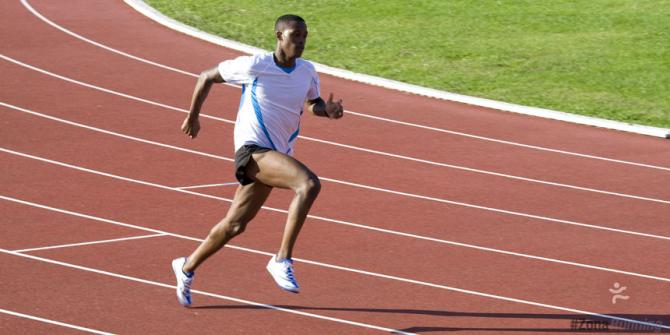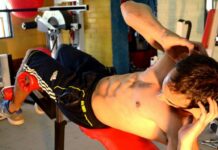Speed is trained above all by exerting a force that is taken to the extreme, within a short period of time, there are two varieties:
Strength-speed, in which runs and jumps are performed with or without load and is performed with powerful and fast movements, in a minimum time. During the realization of this type of speed, the so-called elastic energy is released.

Endurance-speed is based on maintaining a higher speed over a longer period of time. The maintenance of the body in general, of the muscles and fibers is worked on so that they get used to fatigue and know how to cope with it, in order to achieve faster recoveries.
Exercises focused on speed -endurance work.
- Running up the stairs: You can choose any stairs you find near the area where you live, even if the one in your own apartment, chalet, or inside the house if it has several floors. Or do it outdoors in parks or slopes that have them. When you have been practicing them for a while, you can do it with weight in your arms, either by carrying weights and other objects.
- Cross jumps on the ground: Although at first it seems easy, it is not at all; with it you acquire above all agility. You can take two sticks in a park or draw them in the sand with your hand, in the shape of a cross, so there are four squares that you will be jumping. You can start from front to back, and continue with the sides, or crosswise, the important thing is to vary the way you jump the cross and increase the speed with a marked time.
- Jump rope: This exercise has always been practiced as a kind of hobbies in schools, in groups or in physical education classes, but its objective is to work on the resistance part within speed. It is used above all among professional boxers or fighters who introduce it into their training routine. It is a type of exercise that demands intensity and endurance. It can be done with the feet together or apart, at first the classic jump to practice is the most recommended, and then you can include circuits accompanied by the rope, in which different types of jumps and alternate movements.
Exercises based on speed-strength work.
- Race with drag: it consists of a race that usually ranges between 30 and 40 meters in distance, it is carried out in specialized athletics tracks, with the characteristic that the person who runs it carries a dragging weight that is tied at the waist, this weight goes on the ground and can have between 6 and 12 kilos, depending on the preparation of the athlete. Always start with a lower weight and gradually increase it.
- Running slopes: the route of these spaces has a direct impact on the strength in the legs, the more emphasis is placed on this type of exercise, the stride of the foot will be more powerful and of greater distance, thus the performance and the resistance will increase and injury will be prevented.
- Long slopes: this type of slopes has a slope between medium and low and a distance that is between 200 and 400 meters long. Its objective is that the fibers of the muscles get tired. In it the heart is involved with a frequency of between 80% and 85%, the estimated time to travel them is in the 5 or 10 minutes per km. These slopes are repeated between 2 and 6 times and between them you must take a break of 2 or three minutes.
- Short slopes: these are somewhat more complicated since they have a length between 65 and 80 meters and with an inclination that exceeds 8%. When going through them, the stride of the foot requires more energy and when doing them, explosive strength is gained. The required heart rate is between 85% and 95%, and the time required to perform it is a maximum of 5 minutes per km. Between 10 and 12 repetitions are performed, taking a break of a minute or a minute and a half.
- Skipping with ballast: it consists of traveling a distance marking the steps that are taken, raising the knees to the height of the hip, the steps must be between 100 and 150 maximum. In this case, a weight is also used that is dragged and that is tied well to the hip like a belt and can weigh between 8 and 10 kilos or be tied to the ankles, where the weight that is put on would be around 3 kilos. The knee raise can be brought up to the chest, but will require a little more strength.
- Race with dragged parachute: this exercise consists of the weight that the parachute has, which is usually between 4 and 5 kilos. It begins with races that have a distance of about 20 meters, and then 40 meters, 50 meters until reaching 400 meters, they can be divided into 2 or 3 series each. The exercise is based on running until the parachute opens behind the person so that the dragging weight is greater, then the same length is covered, but jogging until the parachute deflates and the legs begin to tire.
- Race with Sprint: it is about the fibers of the muscles adapting to the speed of the race, for them the race in sprint is used. You can start by doing races that last about 30 seconds at the maximum speed possible, making a great effort, between series and series you have to make a recovery of the body that must last a maximum of 4 minutes and that is done with a race which is slower but continuous, which can be done jogging or walking. You can start by doing about 4 sprints.
- Variety of jumps: when performing this type of jumps, the knee joints and the soles of the feet are worked above all. Specifically, it is about improving reactive-type strength in the legs and for them the following modalities are practiced:
- Jumps with feet together: they are performed on stairs or in the stands of a training field or stadium and are done with both feet together. They can be done for about 10 or 15 minutes.
- Go jump: there are different types of go according to their height, the higher they are, the more the hip area is involved. The fences must be separated and can be jumped in different ways, with boats or in the form of a step.
- Jump with plinth: take momentum and with support on the plinth, jump on top of it, to land in the initial position, working mainly on the rebound on the ground. This exercise also requires a certain balance and that the plinth has a good consistency and is well anchored to each other.
- Multi-jumps in a horizontal position: with the body straight in a horizontal position, make jumps in a circuit, jumping obstacles on the ground, interspersing the one leg. You can do 2 or 3 sets each of about 50 jumps.

















